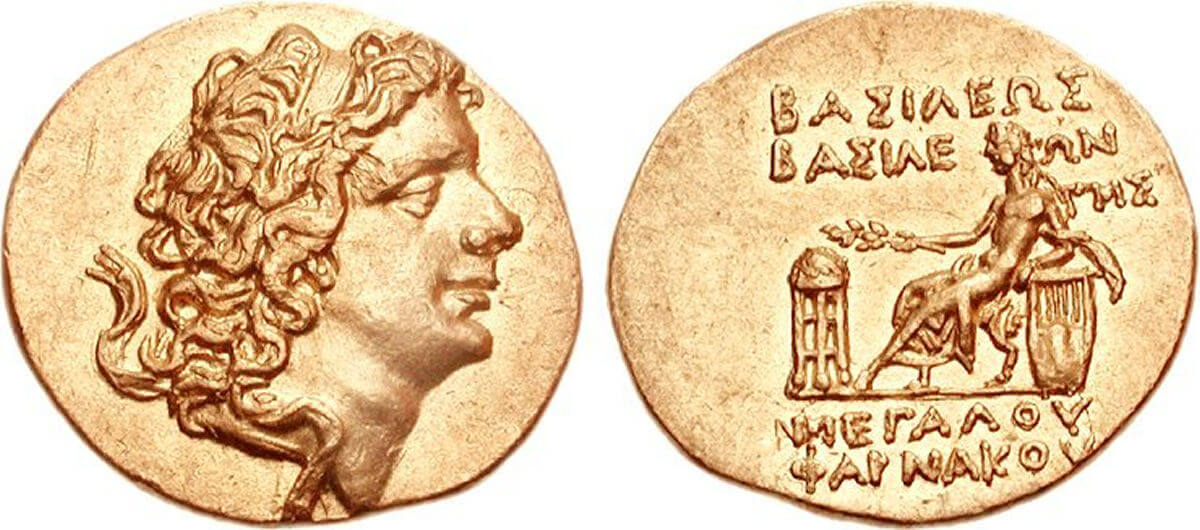Veni Vidi Vici
When Pompey and the Senate fled Rome from Caesar in 49 BC, he did so without an army. As a result, he was forced to draw upon the eastern provinces and allied client states for recruits and supplies. With garrisons and massive levies being shipped off to Greece and Pompey's camp, the east was left dangerously vulnerable.
Pharnaces II, king of Pontus, and son of the great Roman enemy Mithridates VI, used the Roman civil war to his advantage. He began a systematic process of re-taking those lands which once belonged to his father's kingdom, and Rome or its allies could do little to stop it.

Classical Numismatic Group, Inc. http://www.cngcoins.com, CC BY-SA 2.5, via Wikimedia Commons
A gold coin of Pharnaces II of Pontus as King of the Bosporan Kingdom
When Caesar defeated Pompey at Pharsalus in 48 BC, he still had no opportunity to deal with the Pharnaces situation. The war in Alexandria delayed any immediate reaction, and his subsequent affair with Cleopatra occupied his attention for the seasonal winter months of 48 to 47 BC.
Caesar's legate, Gnaeus Domitius Calvinus, was installed as governor of Asia in the interim and did all he could to stop the Pontic advances, but had little success. Calvinus gave battle and the Romans acquitted themselves well, but its allies were cut up badly. Caesar's trouble in Egypt prompted him to request aid from King Mithridates of Pergamum, further depleting the potential resistance to Pharnaces, forcing Calvinus to make do.
In a fortunate turn of events, Pharnaces' appointed governor of Crimea revolted, allowing the Romans to recuperate in Asia Minor for the winter. Meanwhile, Caesar was victorious in Egypt, and the lull back in Asia gave him the opportunity to relax on the Nile with Cleopatra.
By the campaign season of 47 BC, Caesar left Egypt and began an overland march through the far eastern provinces. Heading towards the trouble with Pharnaces, Caesar traveled through Judaea and Syria, accepting apologies and granting pardons to those foreign kings and Roman governors who had supported Pompey. In so doing, he was also able to rebuild his war chest through the various tributes paid to him.
Boarding a ship in Syria, Caesar next sailed to Tarsus in Cilicia, where he called a meeting of the regional leaders. Securing loyalty once again and laying out his plan of action, Caesar continued the march north to Pontus.
Pharnaces meanwhile, well aware of Caesar's approach and his now notorious clemency, asked Caesar for a pardon of his own. Despite the fact that Pharnaces was the only eastern king who remained neutral in the Roman civil war (as all the others in the east had declared for Pompey) Caesar rebutted that only Pharnaces attacked Roman citizens, plundering and killing as he took advantage of the situation.
Still, Caesar offered a peaceful solution, declaring that Pharnaces could be forgiven if he quit Pontus, released Roman prisoners, restored any financial damage done in the process and, of course, pay a hefty tribute.
Pharnaces at first agreed, but it was no secret that Caesar had pressing matters both in Rome and against hold-out Republican resistance elsewhere. Marcus Antonius, appointed by Caesar as his master of horse (Caesar had been appointed to the dictatorship while in Egypt), was sent back to Rome to oversee administration of the city and was not living up to the task. Pharnaces took advantage and sought to delay Caesar as long as possible, hoping he would decide other matters were more urgent, but Caesar had lost patience.
In May of 47 BC, Pharnaces camped his army on a hill near the town of Zela, and Caesar on an opposite hill. The place had historical significance in that Pharnaces' father, Mithridates, had defeated a Roman army 20 years earlier. Separated by a valley a few miles apart, the two armies began to position for battle. Caesar, with four legions, first began to build fortifications, assuming that Pharnaces had no taste for open battle against him, but he soon found this to be wrong.
On or about May 30th, Pharnaces moved his lines towards Caesar, attacking with scythed chariots, but the Romans held them back with their pila spears. The Pontic army engaged full force, and hand to hand fighting erupted across the lines.
Despite their tenacity and the advantage of the initial advance, Pharnaces' forces were likely exhausted from the uphill fight. Before long, their lines began to break, and it was only a matter of time before the entire army was sent into a rout. Pharnaces managed to escape with some cavalry, but the remainder of his entire army was slaughtered or captured in the overwhelming Roman victory. Caesar claimed that the entire affair, including the rounding up of fleeing prisoners, took no more than four hours.
Caesar not only erased the blemish of the earlier Roman loss on this very site, he erected a monument to commemorate just that event. He set about reorganizing parts of the eastern provinces and set up Mithridates of Pergamum as King of Pontus in recognition for his loyalty and service in Egypt. Caesar then crossed from Asia to Thracia, and set sail for Italy.
In the meantime, in recognition of his overwhelming victory, he sent a simple but powerful message back to Rome and the Senate: "VENI VIDI VICI", I came, I saw, I conquered.



